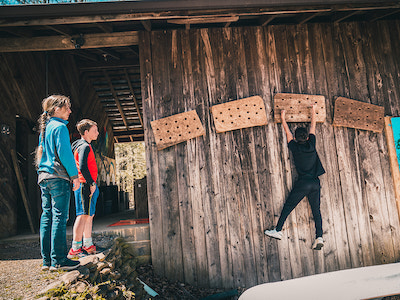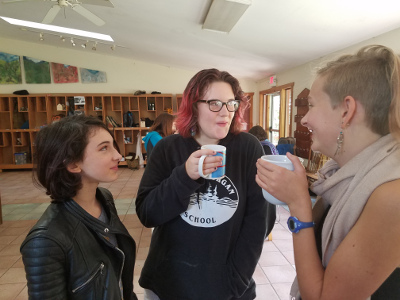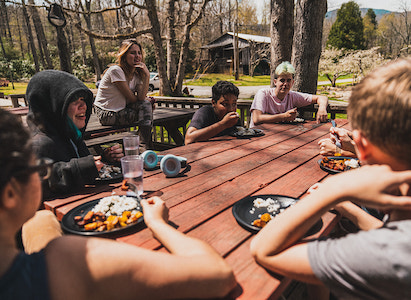Importance of Free Time for Students

It’s a typical Monday morning at AMS. A group of students are riding skateboards on the school courtyard. Another group are climbing an apple tree and talking excitedly. One student sits on the grass reading to themselves while some other students play a board game at a picnic table. These students are not being rewarded. They did not earn this free time by finishing their work early or getting a test done. It’s just 10:30 and that means they all have a half hour of free time before heading on to their next class. If they don’t finish their conversations or games, it’s not a problem. They will another free period later today. At AMS, our middle schoolers get lots of free time. We believe in the importance of free time for students so much that we make it a part of our daily schedule.
Planning a school week is no easy task. Finding time for every class to sufficiently meet while also providing opportunities for art, music, physical activity, and advising requires many schools to set up confusing schedules in which single half hour chunks attempt to satisfy a middle schooler’s need for artistic expression or adult mentorship. AMS is no different. Students sometime spend months trying to remember that the All School Game only occurs on Thursday afternoons. One area we don’t try to cram into a small available slot though is free time. Students need down time. Making it a regular part of their day helps them remember to take care of themselves, to prioritize their needs and interests. It doesn’t matter what they do during that time, just that they have freedom in how they spend it. Providing them that time helps makes them better students.
The Pedagogy of Breaks

Maria Montessori believed in free time. She understood that students need free time to process and practice the lessons they learned during academic periods. Free time gives students the opportunity to play and experiment. It gives them a break from their daily pressures and allows them to incorporate what they learned into their everyday activities and social connections.
Using free time as an educational tool might seem a bit counter intuitive. Our culture tends to prioritize utility and busyness. We are taught to see down time as wasteful and a loss of potential growth. Why allow a kid to skateboard when they could be spending more time understanding math?
Nothing could be further from the truth. Free time actually promotes growth. By providing space for play and open experimentation, the students end up internalizing their education and be more conscious in their actions. We often witness our middle schoolers spending their free time processing what they just learned in class, or applying their knowledge by joking with each other about a topic they just learned. If they just moved from one class to the next, so much of this knowledge would be lost as they became overwhelmed by information overload.
Finding the Time and Space for Free Time
The two biggest hurdles many school face when trying to provide middle schoolers with free time is finding enough time and providing adequate space. School days can feel so short and tightly packed with classes and activities that it’s hard to justify setting aside time to “do nothing.” Additionally, it’s hard to give students the space to feel like their time is actually free. Telling students to do whatever they want in a small classroom doesn’t really allow for the freedom necessary to make scheduled free time feel worth it, but allowing them free roam of the entire school offers supervision challenges.
 One solution is to schedule free time around meals. We schedule breaks for students both during their morning snack and then again after their afternoon chores. Students are allowed to take get their food and then wander around the school grounds while they eat. Combining these two activities helps fit free time into the schedule while also ensuring students are checking in to get food before going off on their own.
One solution is to schedule free time around meals. We schedule breaks for students both during their morning snack and then again after their afternoon chores. Students are allowed to take get their food and then wander around the school grounds while they eat. Combining these two activities helps fit free time into the schedule while also ensuring students are checking in to get food before going off on their own.
We also include long periods of free time at the end of the school day. AMS’s school day goes from 8:30 to 5:30 many days. Extending the school day may not be a popular decision with your teachers, but there are ways to supervise these times without taxing your staff. At AMS, only two staff members oversee the whole school during free time periods. Students check in with them and communicate where they will be. The staff walk around, providing supervision while also giving students space to explore freely. The middle schoolers feel trusted and recognize the responsibility and privilege being bestowed upon them.
Excited for your student to understand the importance of free time and how to use it effectively? Learn more about it by talking to our admissions coordinator!
During free time periods, our students get free use of the campus. They can go walks, use our art studios, visit the library or just hang out in classrooms. Sometimes our students opt to use free time to practice concepts they are learning. They try to apply a lesson to their real life by building something for themselves. Having many opportunities to use their body freely and express themselves is key to making free time successful and worth it. The students are taught to use the school spaces responsibly and clean up after themselves. They enjoy having so many spaces open to them, and as a result, feel ownership over the school.
While scheduled free time in the school day can be challenging to accommodate, finding the time to make it happen is worth it. Free times provides students with a sense that they are trusted, responsible members of your school community. It gives them the time they need to process and recuperate between classes. As a result they will be more engaged in their classes and more excited to come to school every day!
-by Nicholas Maldonado
